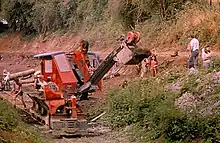
Waterway restoration is the activity of restoring a canal or river, including special features such as warehouse buildings, locks, boat lifts, and boats.
In the United Kingdom, Canada, and United States, the focus of waterway restoration is on improving navigability, while in Australia the term may also include improvements to water quality.
Waterway restoration in Canada
Shubenacadie Canal
The Shubenacadie Canal Commission was formed in 1986 to oversee the future of this waterway. Locks three and five have been restored, water levels in the connecting lakes have been stabilized and a visitor center opened. The ten-year business plan for 2007-2016 aims to save four more locks and rebuild four water control structures to make the route open for small boats from Lake Banook to the village of Shubenacadie.
Soulanges Canal
The Soulanges Canal closed in 1958. Today there are plans to reopen the canal to pleasure boats. The mission of the Régie intermunicipale du canal de Soulanges is to manage the development of tourism development as part of the reopening of the canal.
Waterway restoration in Finland
Suvorov military canals
Suvorov military canals (Suvorov canals) are series of four open canals on Saimaa Lake in Finland. Apart from the Kutvele canal, the other three canals spent 200 years almost untouched from the early 19th century until 2003, when the Finnish National Board of Antiquities began restoration works on them. Now they have been turned into tourist attractions.
Tar canals
The tar canals in Kajaani were canals and locks built to pass the Koivukoski and Ämmäkoski rapids. First used in 1846, the locks were vital in the transportation of wood pine tar to Oulu. The worn-down canals were closed in 1915. The refurbished Ämmäkoski lock was re-opened in 1984, but the Koivukoski canal has been totally dismantled and the site now houses a hydroelectric power plant. The refurbished canal is not used for transport, but in the summertime, tar boat shows are organised for tourists.[1][2]
Waterway restoration in the United Kingdom

Due to competition from the railways and the narrow design of most UK canals (which prevented the carriage of economically sized bulk loads), large parts of the UK's canal system were abandoned in the late 19th and early 20th centuries. The rise of the leisure industry in the 1950s meant that the complete abandonment of the remaining canals was avoided.
The increasing use of canals for leisure purposes led some people to consider restoring some of those that had been abandoned. At first, progress was slow due to the lack of funding, with most of the work having to be done manually by volunteers.
As the leisure industry grew, the economic benefits of having a canal became more apparent and some state funding started to appear. At the same time, public interest increased the size of various volunteer groups.
At the present time, canal restoration in the UK is carried out by a mixture of volunteers and professionals working on a large variety of projects.
Waterways under restoration

- Buckingham Arm
- Chesterfield Canal
- Chichester Canal
- Cromford Canal
- Dearne and Dove Canal
- Derby Canal
- Grand Western Canal
- Grantham Canal
- Hatherton Canal
- Hereford and Gloucester Canal
- Lancaster Canal
- Lapal Canal (Dudley No 2 Canal)
- Lichfield Canal
- Liskeard and Looe Union Canal
- Manchester Bolton & Bury Canal
- Monmouthshire & Brecon Canal
- Montgomery Canal
- Pocklington Canal
- Rolle Canal
- Sleaford Navigation
- Stroudwater Navigation
- Thames and Severn Canal
- Wendover Arm Canal
- Wey and Arun Canal
- Wilts and Berks Canal
Waterway restoration groups in the United Kingdom

- Waterway Recovery Group
- Buckingham Canal Society
- Cotswold Canals Trust
- Inland Waterways Protection Society
- Kent and East Sussex Canal Restoration Group
- Montgomery Waterway Restoration Trust
- River Stour Trust, Suffolk, England
- Shrewsbury & Newport Canals Trust
- Somerset Waterways Development Trust
- Wendover Arm Trust
- Wilts & Berks Canal Trust
- List of waterway societies in the United Kingdom
Completed restoration schemes
Waterways are listed in chronological order of re-opening. Most have been completely re-opened, but some (such as the Grand Western Canal and Basingstoke Canal) are only partially complete but have no current plans for work on the rest of the line.
- Lower Avon 1962
- Southern Stratford canal 1964
- Stourbridge Canal 1967
- Grand Western Canal 1971
- Upper Avon 1974
- Peak Forest Canal 1974
- Caldon Canal 1974
- Ashton Canal 1974
- River Great Ouse 1978
- Kennet and Avon Canal 1990
- Basingstoke Canal 1991
- Bridgwater and Taunton Canal 1994
- Huddersfield Narrow Canal 2001
- Rochdale Canal 2002
- Droitwich Canal 2011
See also
Further reading
- Squires, Roger W (1983). The New Navvies. A History of the modern waterways restoration movement. Chichester: Phillimore & Co. ISBN 0-85033-364-4.
References
- ↑ "Tervakanavan soutunäytökset". Kajaani.
- ↑ "Avstängd webbplats". kanaler.arnholm.nu.